The history of synthesizers is a rich and vivid saga, covering a wide range of music and designs for over 50 years. As with any story, there's a significant main cast with a continual presence throughout the entire series of events, but there are often several interesting minor characters appearing at pivotal moments. In this article, we're not going to be discussing the specifics of an instrument from Moog, Roland, or any of the immediately familiar names in synthesizers, but rather shining a light on a lesser-known modular synth: the Fénix.
At first glance, Fénix looks much like any other synthesizer with patchable connections, and indeed sounds like one, too. Yet what's significant and special about the Fénix is not just what it is or what it does, but also the history and context behind its development, and why the timing of its release was fairly significant in the sequence of synthesizer developments leading up to the present day.
We were ecstatic to spend some time with this rare, near-vintage instrument recently, and you can catch a handful of its sounds in the video linked above. But if you're curious to learn more about the deeper details of what makes the Fénix so compelling, read on.
Looking Back on Synthesis in the 1990s
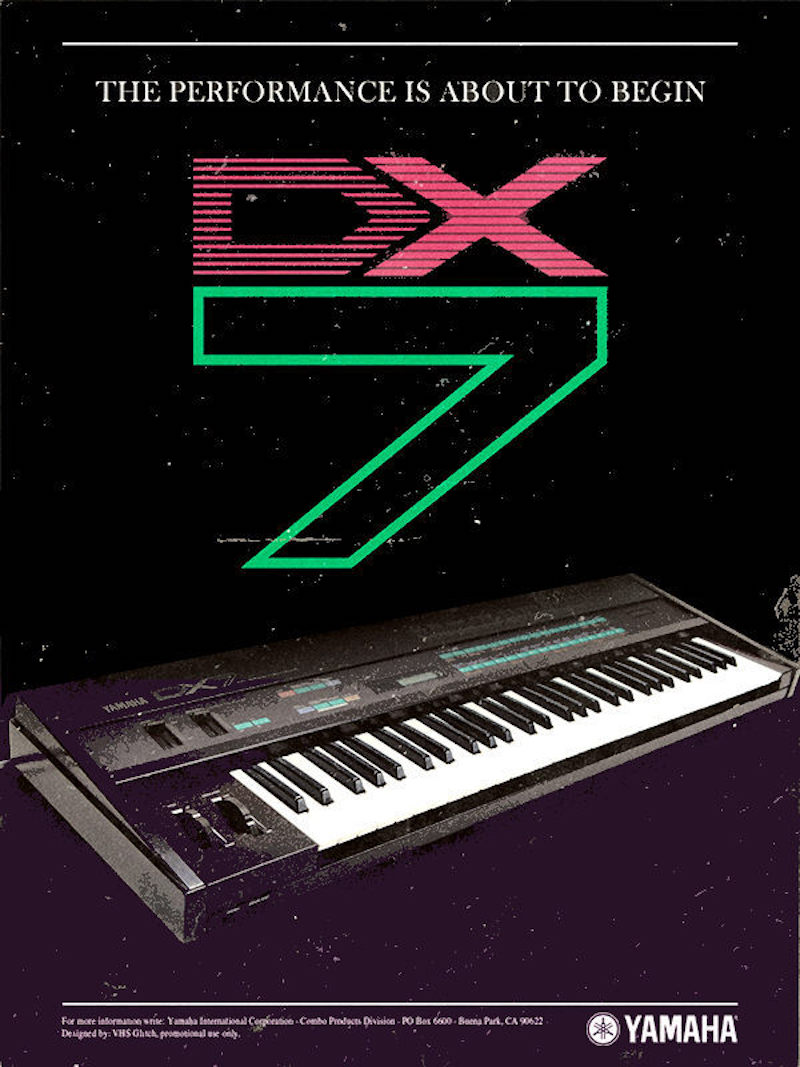
In some ways, the 1990s were a precursor to the synthesizer renaissance of today. After the flood of products released in the wake of Yamaha's powerhouse FM synthesizers towards the end of the 80s, many synthesists had grown weary of digital instruments and were cycling back towards old analog synthesizers, even as computers began to play a central role in recording and composition. Many of the synths we now consider iconic were starting to attain their legendary status around this time, by combination of artists breathing new life into antiquated analog instruments and their (at the time) relative ease of availability at a fraction of their original market price.
However, the internet was still in its infancy, and general computers were a far cry from even our current smartphones and tablets, so the sharing of information on synthesizers and electronic music was largely still dependent on printed publications, word of mouth, and... you know, listening to music. But nonetheless, buzz was forming around analog instruments again, and even with the rise of software and laptop-based music just after the turn of the millennium, a lot of what's happening today in the world of synthesis can be traced back to developments made in the 90s. So when people were first rediscovering and igniting newfound passions for these synthesizers, many of them were likely left wondering: surely there's something new and exciting being developed in the realm of analog synthesis?
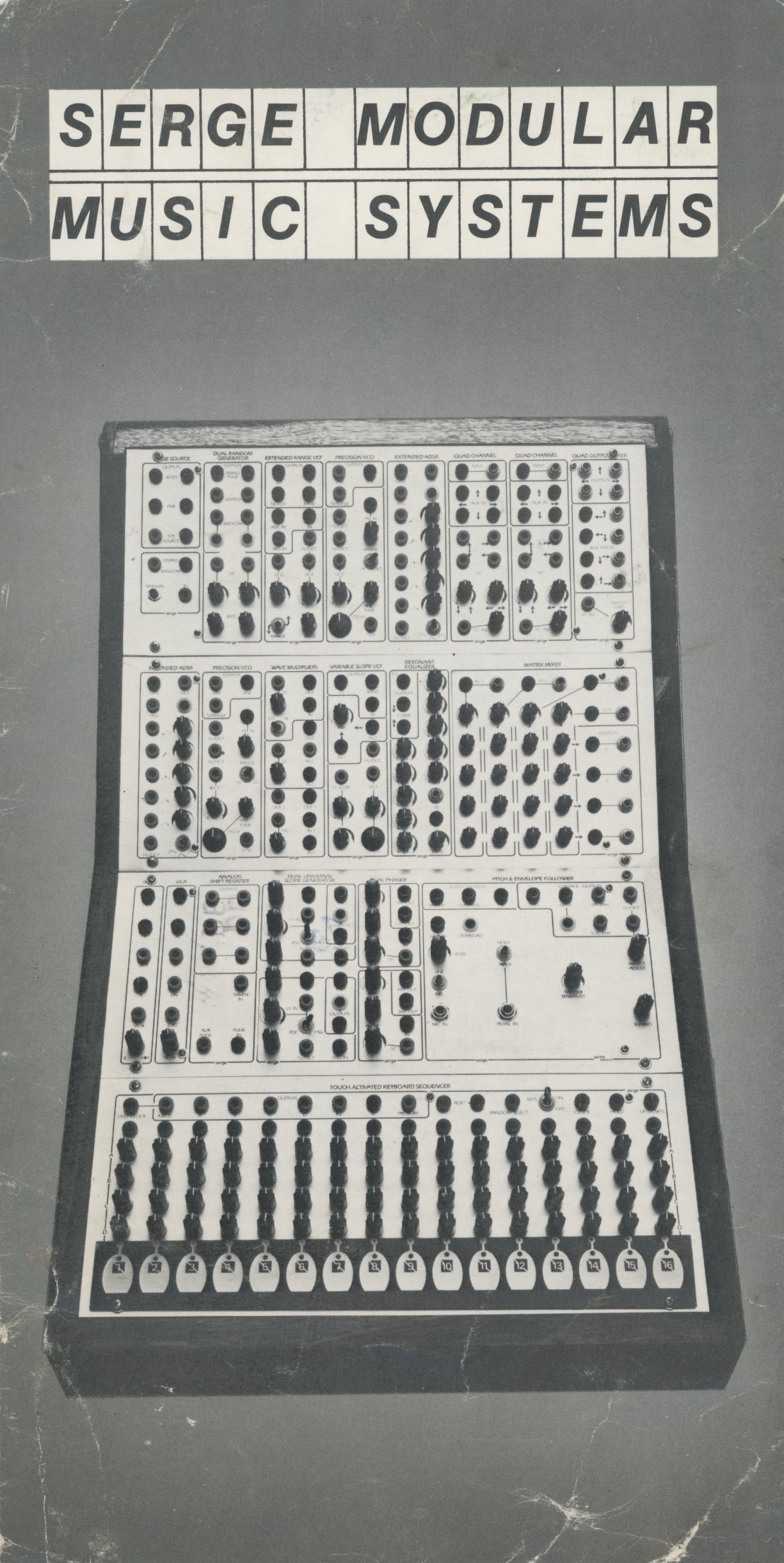
Yet at this point in time, many of the biggest names in electronic musical instruments were out of the synthesizer game, or life had simply moved them in different directions. Robert Moog left his namesake company in the late 1970s (and the original Moog Music ceased operations in 1987), and was making theremins, controllers, and even distributing products for other companies under the name Big Briar. Don Buchla had shifted away from designing full synthesizers and was working on alternative MIDI controllers, like the Thunder, while also consulting on designs for other companies, like Oberheim's OB-MX. Dave Smith briefly worked for Korg, adapting concepts from some of the final Sequential Circuits products into new instruments, such as the Wavestation which built upon concepts of the Prophet VS, before moving on to develop some of the first software synthesizers.
The big companies that were producing synthesizers, like Roland, Korg, and Clavia/Nord, were still more interested in producing digital instruments, even going so far as to introduce the concept of "virtual analog"—digital synths emulating the sounds of their analog predecessors. This was an understandable choice, given the increasing power and excitement around digital processors at the time, and is certainly more cost effective in production.
So until the mid-to-late 90s, your options for a true analog synthesizer were few and far between, especially in the realm of modular. Sound Transform Systems had assumed commercial production of Serge panels, but the availability of kits that afforded the DIY heritage of Serge ended in the 80s when Serge Tcherepnin left the United States. So while STS was building phenomenally produced panels with premium quality, building a Serge system was certainly not as affordable as it once was. But eventually, new analog designs started to manifest as enthusiasts took matters into their own hands. In 1995, Dieter Doepfer unveiled a small instrument known as the A-100 modular system—a fledgling of what Eurorack would eventually grow to be. Others like the 5U Synthesizers.com format and Grant Richter's Wiard modular were also just getting off the ground around this time, so the renewed interest in analog synthesis was spurring new ideas left and right. And then towards the end of the 20th century, rising from the ashes of a defunct synthesizer company, Fénix emerged.
Before Fénix: Synton - Distributor and Maker

In the early 1970s, composer Felix Visser founded Synton upon repairing his recently-purchased EMS Synthi AKS. Like many that get into this business, the process of taking apart an instrument and bringing it back to life inspired a number of ideas for new devices. And by the 80s, the Synton lineup was full of variety, offering not only modular synthesizers but a range of effects and audio processors as well. Their System 3000 consisted of Curtis IC-based circuits packaged into 3U modules with banana patch points—tiny for their time but not far off from what Doepfer's later Eurorack modules would look like. Synton themselves were European distributors for companies like Fairlight, E-Mu, and others, but in the US were distributed by Bob Moog's Big Briar, and their modular synthesizers were often seen paired with Big Briar controllers in ads and catalogs.
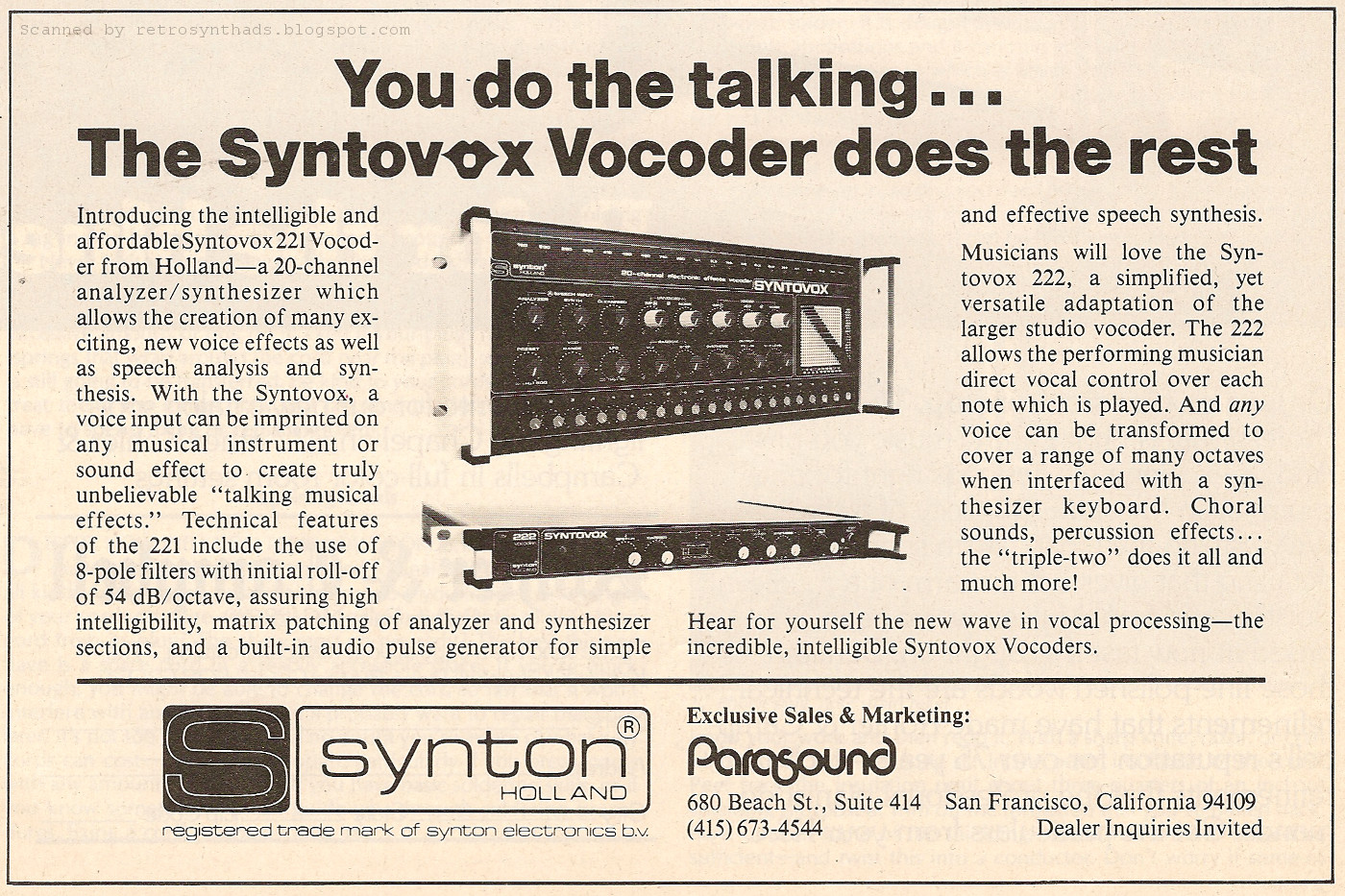 Syntovox advertisement from the 1980s (image from Retrosynth Ads)
Syntovox advertisement from the 1980s (image from Retrosynth Ads)
But aside from their synthesizers, the thing Synton perhaps became most well known for were their incredible vocoders. Used by the likes of composers such as Wendy Carlos, the Syntovox 222 and SPX-216 were a popular choice for studios working on all kinds of sound and music. While vocoders were not new technology by the 80s, Synton's products in particular were known for raising the level of intelligibility and offering immense flexibility, one reason Carlos herself was particularly drawn to these units.
Synton introduced the Syrinx in 1983, an analog keyboard synthesizer largely based upon Curtis chips, just like the modules of the 3000 system. At first glance it might look like any old monosynth, but it offered a unique metal touch-plate controller, a cool assortment of signal routing options, and a dual-peak formant filter with voice-like characteristics. While it was an interesting design, it had the unfortunate timing to be unveiled alongside Yamaha's DX7, which perhaps single-handedly spelled the end of the first era of analog synthesizers.
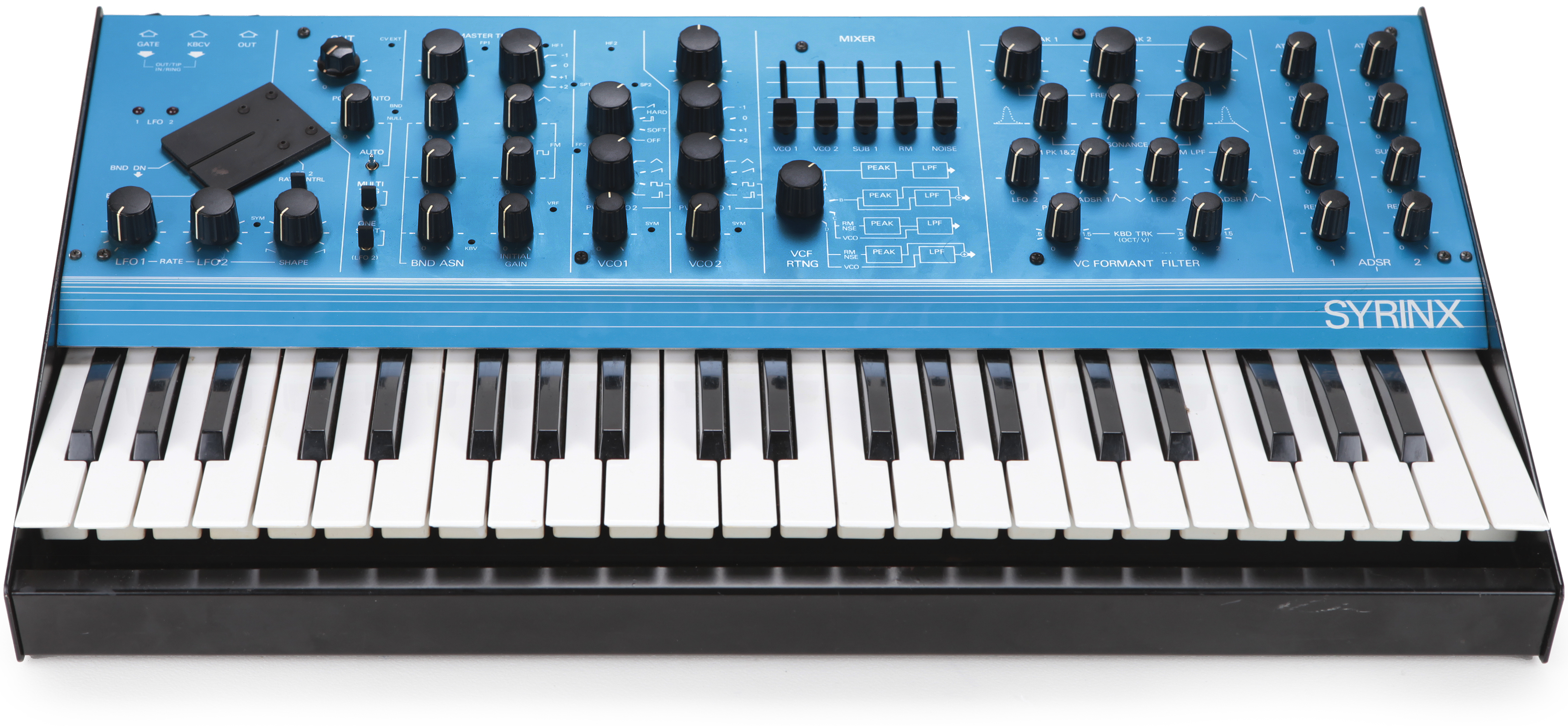
It's this failure which perhaps also signaled the beginning of the end for Synton, later shutting down in 1989. After Synton closed, Visser returned to other projects, while product designer Bert Vermuelen began dreaming of a new modular instrument.
Fénix Design Background
With concepts from the Synton 3000 system and Syrinx as a loose guide, Vermuelen sought to craft the ideal modular synthesizer in what would later become the Fénix. The project initially began as a single run of just 25 units, mostly shared with colleagues and friends. But eventually, word got around of an impressive new synthesizer coming out of the Netherlands, and so roughly 50 more were built to appease demand. At the end of the day though, this was always destined to be a limited run instrument. Fénix was a labor of love by the former Synton employee, and came to exist purely due to what Vermuelen needed in a synthesizer at the time, with a few dozen others lucky enough to get in on the magic too. It should be noted that Synton's founder Felix Visser had no significant involvement in this project, but did assist in designing the logo and stylizing the front panel.
A guiding principle in designing the Fénix was to use easily accessible components wherever possible. Where integrated circuits were necessary over discrete components for the circuit design, most that are used in the Fénix can be easily sourced in the event it must be serviced, like the ubiquitous TL074 op-amp. This contrasts even with the Synton 3000 modules, which made extensive use of Curtis chips that were common in a lot of synths at the time, like the CEM3340, but became more difficult to acquire after analog synths fell out of fashion.
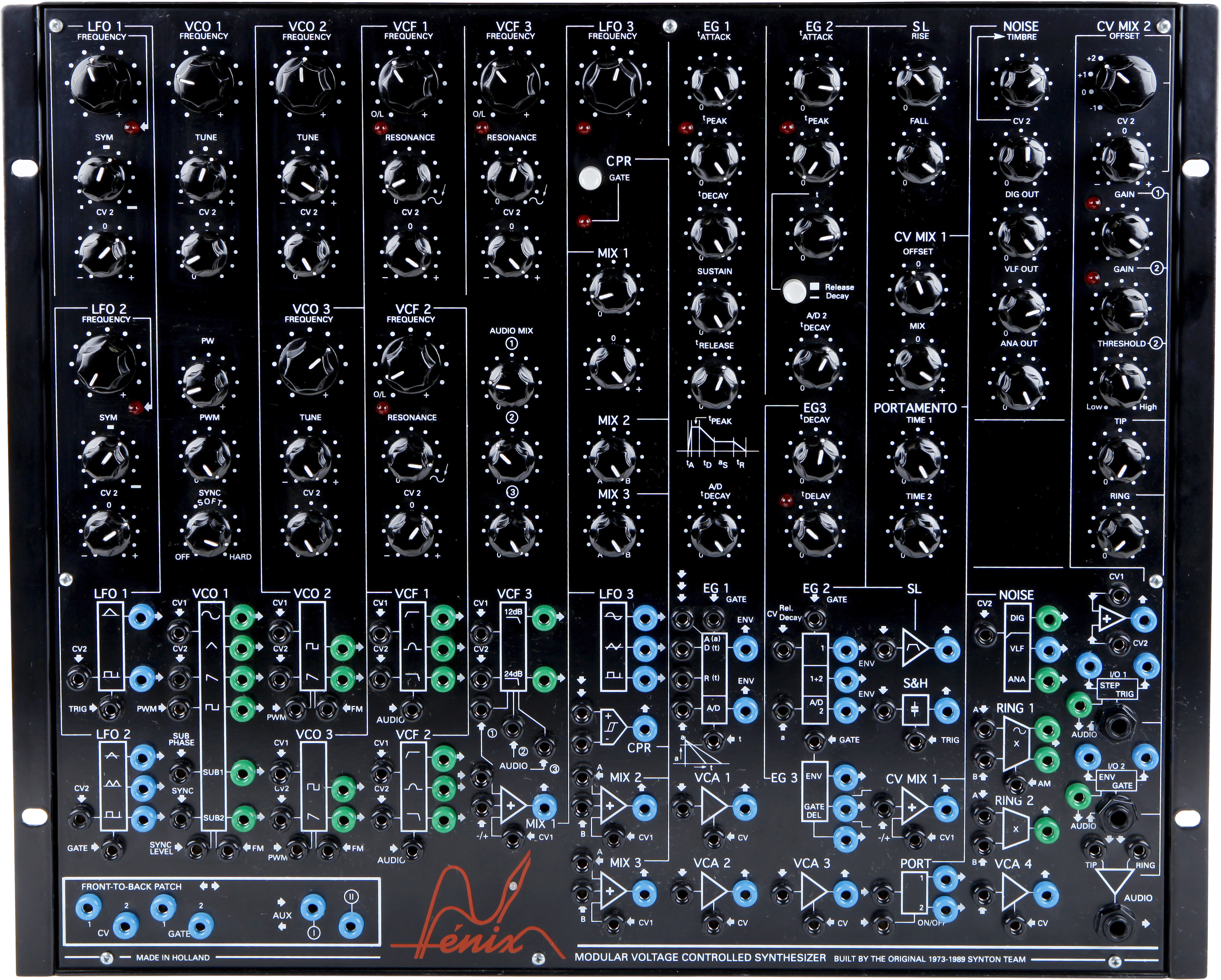
Looking at the instrument itself, one can notice that a lot of Vermuelen's preferences in synthesizer ergonomics and feature sets made their way into the design of the Fénix. For starters, while Fénix is totally fixed in the selection of modules that it provides, there are notable functional differences between sections of the same type. As an example, each of the three LFOs offer a unique set of waveforms at their outputs, and vary slightly in their manual and control voltage inputs (actually, LFO 3 offers no CV inputs at all!). This means that even discrete sections of the instrument that offer similar functions can still have unique roles within the greater context of a patch. And even though the modules share a single panel and enclosure, there are no normalled connections as you might find in a semi-modular synth like the Korg MS-20, so even the most basic patches require some amount of patching.
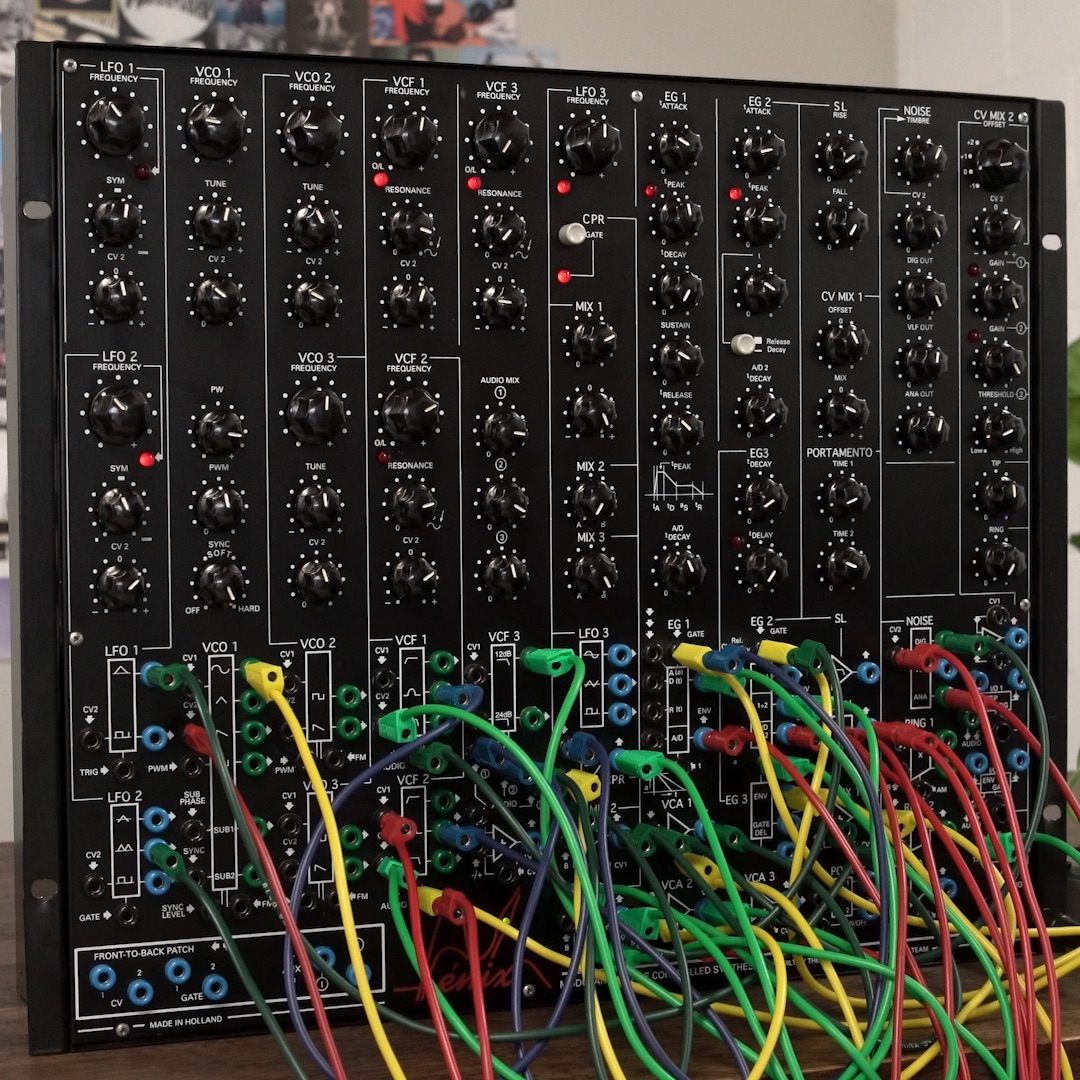
Speaking of patching, there's another distinct advantage to using a single panel for the Fénix. A clear separation of controls and patch points means that no matter how dense a patch may be, there's no need to dive through a tangled mess of cables to reach the most vital knobs. Fénix encourages a very hands-on approach, and so with patching activity distinctly at the bottom and separate from the knobs above, both manual and voltage control may live together in beautiful harmony! In regards to the patch points, there's a general adherence to a left-to-right and top-to-bottom flow, with a few minor exceptions here and there likely arising from the specifics of board layouts and arrangement.
Like Serge panels and the prior Synton 3000 systems, Fénix uses banana cables for patching. Most banana cables allow for stacked connections, thus the user is free to route a single output to several input destinations and build up thoroughly interconnected modulation networks and dynamic patches. However, the modules in the Fénix are designed with more explicit functions in mind, offering dedicated LFOs, ADSRs, and utility modules, rather than something like the Dual Universal Slope Generator found in the realm of Serge, which has a number of possible functions defined by "patch programming" it. Even so, the inherent freedom of modular patching workflows and slight variations in the available controls on a per-module basis make the Fénix a uniquely enjoyable instrument in its own right.
Fénix In-depth Rundown
As mentioned before, Fénix has a plethora of modules and capabilities, but now we're going to take a deep dive and look at what it has to offer. Before doing so, it's worth mentioning a couple of conventions that are apparent in the panel layout and controls that are offered.
First, the banana jacks follow a simple color coding scheme: black jacks are inputs, and blue jacks are generally considered control voltage outputs, while green are audio outputs. Of course, in some real-world patching scenarios there are exceptions, but it does afford newcomers some immediate association to a module's purpose. Next, controls that are labeled "CV2" generally have an attenuator, either unipolar or bipolar, while "CV1" (or just "CV") inputs have no manual level controls. This is particularly clear on the VCOs, but without knowing this distinction it could otherwise be strange to notice a CV2 as the only control input, as seen on LFO 1 and 2.
Now, let's move on to the juicy details of what this stellar instrument can do!
Three and Three: Oscillators and LFOs
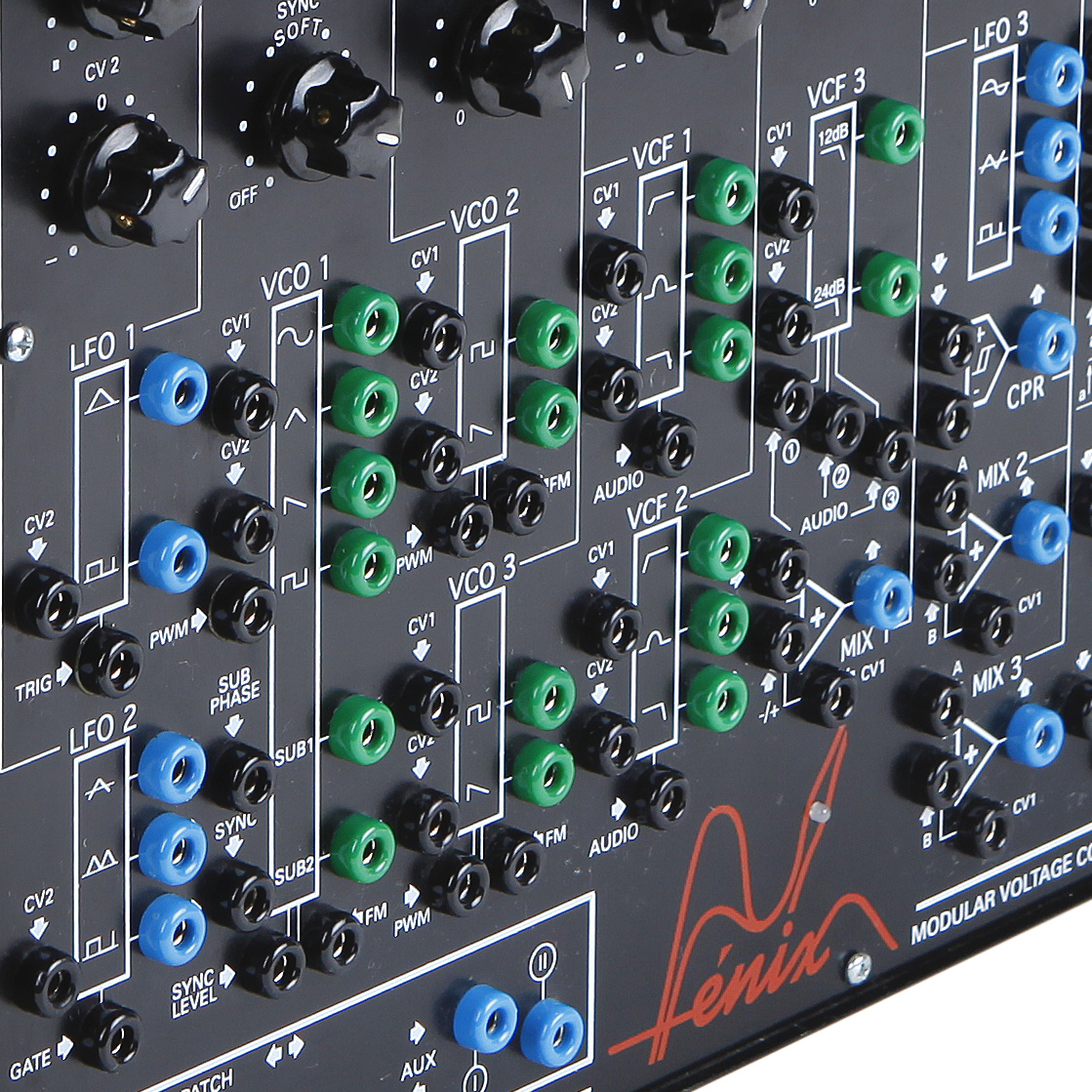 Fénix LFOs, VCOs, and VCFs
Fénix LFOs, VCOs, and VCFs
As all great synthesizers need a basic building block for generating sound, Fénix comes prepared with three VCOs for traditional synth tones and audio-rate modulation sources. In particular, the first VCO is a highly utilitarian oscillator, providing all four basic waveforms (sine, triangle, sawtooth, and square) as outputs, plus two sub oscillator outputs. Although its primary purpose is as a sound source, with the help of some negative offset voltages it can be useful to push this oscillator down below audio-rate, turning it into a super-charged LFO. Even though there are already three dedicated LFOs (more on these soon), their control inputs afford unique patch utility in ways that tuning down a VCO won't yield too much functional overlap. One patch I particularly enjoy is summing the square wave and both sub outputs of a low-tuned VCO 1 together to create staircase voltages that can be used as pseudo-sequences—a helpful thing as the Fénix has no sequencer of its own.
 Hard and soft sync diagrams from the Fénix manual
Hard and soft sync diagrams from the Fénix manual
The first oscillator also offers extensive FM and pitch control possibilities, and when used in sync configurations, the intensity is variable from soft to hard sync, both manually and via control voltage. The other VCOs are much more limited in comparison to their companion, only offering square and sawtooth waveforms, and CV inputs for pitch, linear frequency modulation, and pulse-width modulation. But the comparative lack of functionality shouldn't be viewed in a negative light—their uses in patching them together and among other modules on the Fénix extend greatly beyond simply producing harmonically rich timbres.
Alongside the primarily audio-rate VCOs are three complementary LFOs, with each one bringing something different to the table in their outputs and control capabilities. For patching convenience, the first two LFOs are at the far left of the panel, while the third is situated in the middle between the filters and all the other utility functions. In terms of functionality, it's actually the third one that is the most straightforward, providing bipolar sine and triangle outputs, a unipolar (or positive-only) pulse output, and a single frequency control above with no CV inputs.
Jumping back to the left, LFO 1 and 2 are similar in their panel controls—both provide a base frequency control, symmetry for skewing the triangle into ramp waves or modifying pulse-width, and a CV attenuverter for dialing in the level of control signals. In terms of the actual I/O, LFO 1 provides unipolar triangle and pulse outputs, the aforementioned CV input, and a trigger input for resetting the phase of the waveform. On the other hand, LFO 2 instead has both bipolar and full-wave rectified triangle outputs, with the latter thus being unipolar and double the base frequency, and swaps the trigger input for a gate input, instead only passing the LFO output when a high gate signal is present.
Spectrum Shaping Galore: Triple VCFs
Looking at some of the modular instruments of legend, it's fairly common to see one or two filters on patchable synthesizers, commonly manifesting as a single state-variable design or a dual configuration of lowpass and highpass filters. But Fénix, the generous being that is, offers three VCFs, which is plenty for even the most dense patches. Unlike the prior Synton designs based on CEM chips, all three filters are original circuits making use of more commonly available components, but still deliver juicy timbre shaping like any of history's great filters.
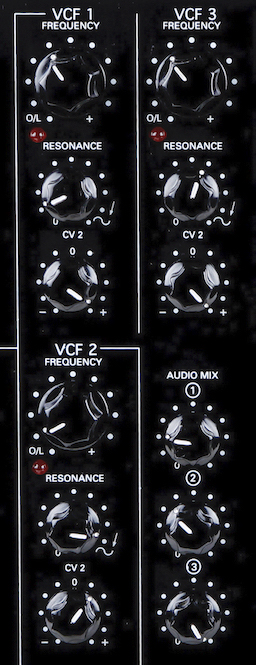
The first two VCFs are identical in operation and feature set—they're resonant, state-variable filters with 12dB/Oct slopes, offering simultaneous outputs with lowpass, highpass, and bandpass responses. The lack of bandstop response might initially seem strange, but given the abundance of mixers and summing circuits on the Fénix, patching up parallel lowpass and highpass signal paths to create a notch filter should be no trouble at all. These particular filters have abundant resonance, making them exceptionally great for pinged filter percussive patches. Of course, this also means they'll work great as sine wave oscillators, and the CV 1 inputs will track 1V/Oct pitch sequences wonderfully, while the CV 2 inputs with their attenuators make it easy to dial in subtle (or drastic) modulation.
Rather than being a multimode design like the others, VCF 3 is a classic, ladder-type lowpass filter with a three-channel input mixer. Though not an exact copy, it's perhaps pretty clearly inspired by the filter found on the Minimoog Model D, but rather than simply offering a four-pole 24dB/Oct slope, there's also a 12dB/Oct output as well for a more gentle rolling-off of higher frequencies. This is the go-to filter in the Fénix for punchy basses and warm, rounded timbres in the spirit of the classic analog monosynths that preceded it.
The VCF 3 mixer is, of course, handy for processing multiple different sounds through one filter, but it's also a chance to take advantage of some less obvious implications. Running two or three copies of the same signal into multiple channels can drive the filter harder, imparting distortion and generating more harmonics to then be filtered out. I also particularly enjoy running a raw oscillator into one input, then running copies of that signal into the other two filters, and taking their bandpass outputs into the other inputs on the mixer. Dialing in some moderate resonance on the bandpass filters will accentuate certain harmonics, resulting in a rather vocal, formant-like sound that can be incredibly expressive, especially on patches utilizing oscillator sync or FM.
Flexible Modulations: 3 + 2 Envelope Generators
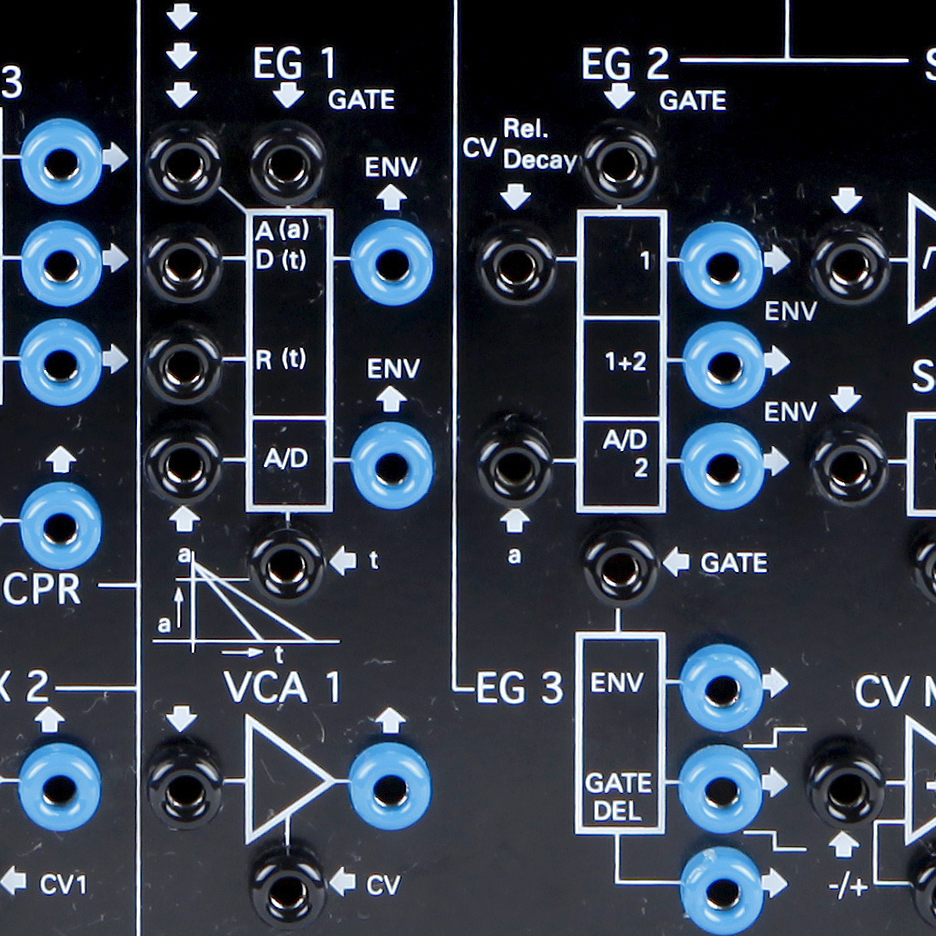
Historically, the quintessential modulation companion to the LFO has always been the trusty envelope generator, which Fénix delivers in spades. There are three EG sections on the Fénix, but in a way there are actually five envelopes to be had, as two have a secondary decay envelope built-in that shares a gate input with the primary EG. Like the LFOs, each envelope has something unique to offer that isn't found on the others.
The first EG provides the Fénix with the ubiquitous ADSR envelope, but with a bit more flexibility on tap. Unlike most ADSRs, this one provides a Peak duration control, sometimes referred to as Hold on other instruments, which defines how long the envelope is momentarily held at its maximum voltage after the attack stage, before decaying to the specified sustain level while the input gate remains high. There's also plenty of control voltage inputs for modifying the Decay and Release times, as well as the maximum amplitude of the attack stage. While the linked decay-only envelope shares a gate input with the full envelope generator, it has its own output and offers two CV inputs: accent (or amplitude) level, and decay time. This joined architecture of envelope generators is incredibly convenient, affording patch scenarios where the secondary envelope might be used for accent purposes, such as briefly opening a filter at the beginning of a note, while the primary envelope fades in an additional layer of sound that isn't initially present.
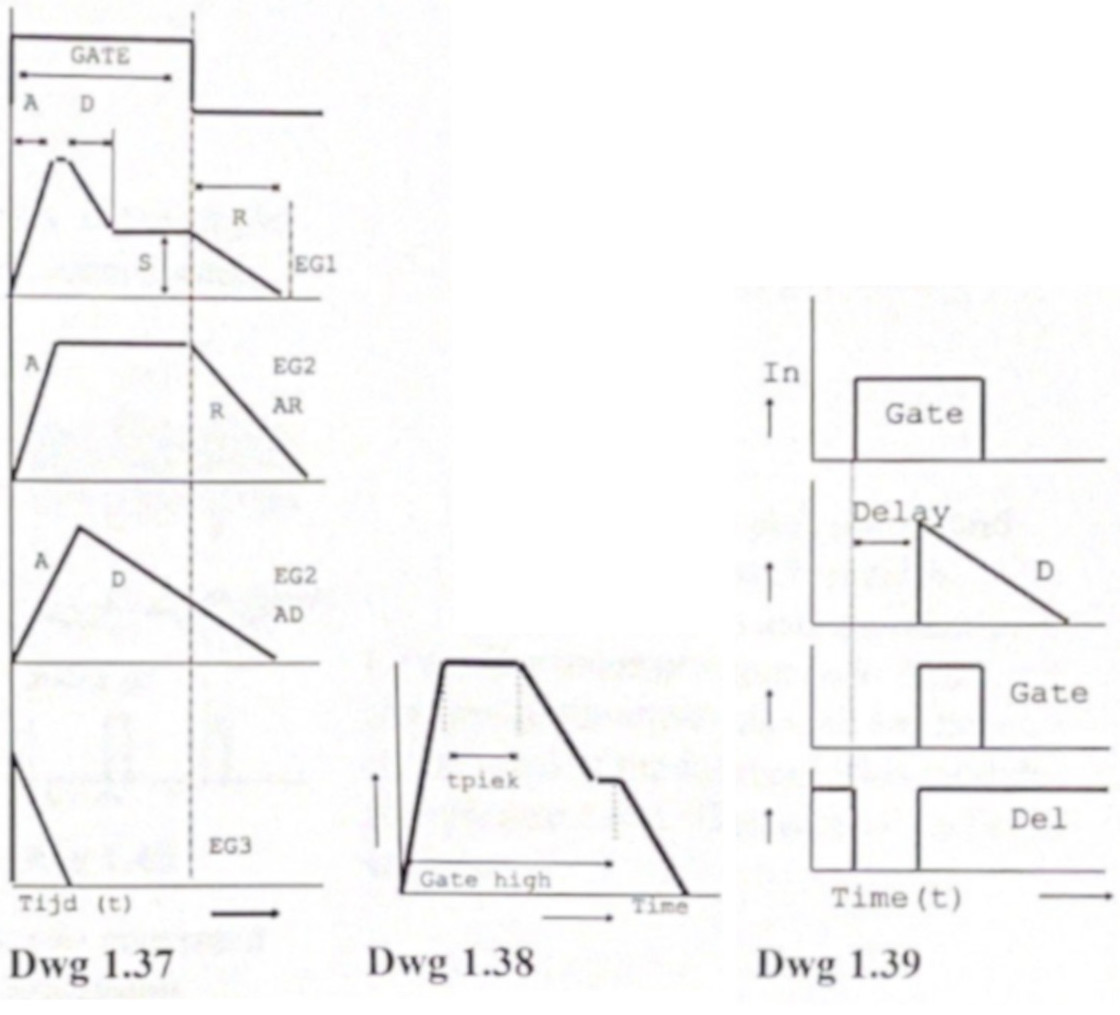 Diagrams of each primary envelope generator from the Fénix manual
Diagrams of each primary envelope generator from the Fénix manual
Similarly to what was established in other sections of the Fénix, the other two envelope generators are comparatively simpler than the first. EG 2 functions as either an attack/decay or attack/release envelope, both with variable peak length. The decay/release functionality is set by a toggle button, and will change how the envelope responds to sustained gate signals. In Decay mode, gate lengths longer than the Attack stage are ignored, and will immediately begin to fall after the end of the Peak stage, while Release mode is solely dependent upon the length of gates, and will disregard the Peak stage entirely.
And as with the first EG, there's a linked decay-only envelope in this section as well, but this time there's a mixed output of the sum of both envelopes, offering the synthesist a free source of slightly more complex modulation. EG 3 is just a straightforward Decay envelope with no control inputs, but it also contains an ever handy gate delay, which can be incredibly useful for establishing cyclical systems of control signals triggering the activation of other modulation voltages.
Signal Management: Mixers, VCAs, and Ring Modulators
As with any modular instrument, patches really begin to shine when making clever use of basic utilities—combining and controlling various signals with one another. Fénix thus offers plenty of ways to join, blend, and modulate both audio and control signals.
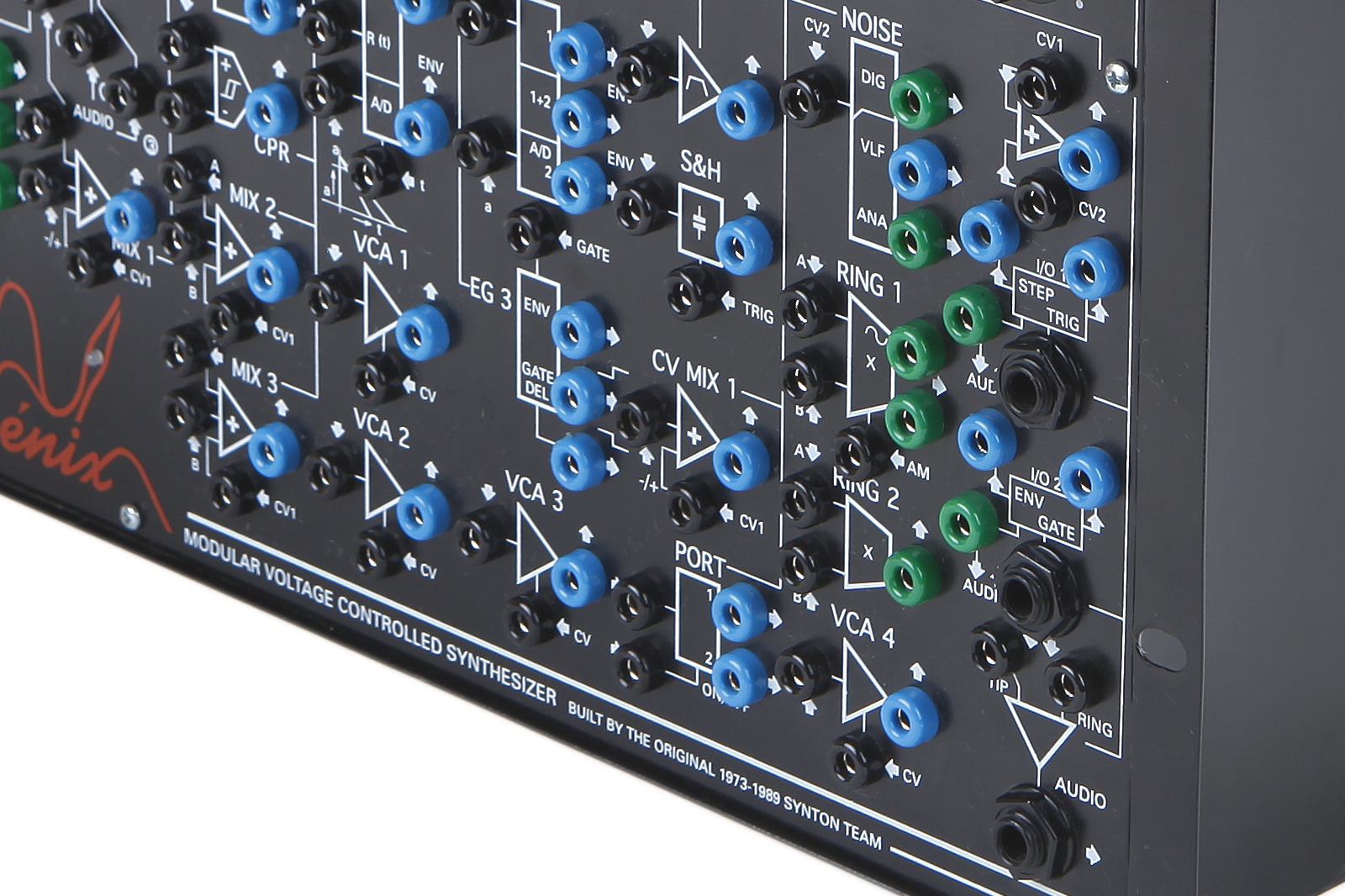 Fénix utility patch points
Fénix utility patch points
For the purposes of simple signal summation, there are three basic mixers which accept audio or CV signals. Each offers three inputs and one output, though their panel controls differ slightly, in true Fénix fashion. MIX 1 offers dedicated level controls for its inputs, with one functioning as a polarizer for inverting a signal if desired, while MIX 2 and 3 crossfade between their A and B inputs. All three of them also have a CV1 input, which simply adds another signal at unity gain—handy for cascading mixers together without one further down the line affecting the level of the prior units.
The four VCAs allow for basic manipulation of one signal by another, like when controlling the amplitude of an audio signal with an envelope generator. These also allow for complex modulation signals to be created, for example using an LFO to modify the depth or level of an envelope or another LFO. Since they're fully closed at zero volts, VCAs don't respond to negative voltages, so sticking with envelope generators or the unipolar outputs of the LFO modules as the control signal will bring about more predictable patching results.
Somewhat similar in function to the VCAs, Fénix also has two ring modulator sections. Like a VCA, a ring modulator can control the level of an input signal via another source, but the key difference is that the control input will accept negative voltages, thus inverting the output when control signals fall below zero volts. This means ring modulators are effectively a true multiplication circuit, behaving just as you had learned in arithmetic class when multiplying positive and negative numbers together. The only difference between RM 1 and RM 2 is the presence of a third input for amplitude modulation on the first—ideal for patching in a control signal to affect or be processed by the ring mod.
Utilities Roundup: Noise, S&H, Comparator, and More!
If you've made it this far into the article, it should be clear that Fénix is simply packed full of highly flexible musical circuits, and yet there's still more to talk about. Nestled within much of the right half of the panel—the control side of Fénix, as it were—between all of the envelopes and VCAs are a number of utility blocks to manage complex patches. Many of these may be used to subtly modify audio or control voltages for a variation upon a desired result, like transposition, applying offsets, or unlocking a number of advanced patching tricks. There's a lot to mention here, so we'll start mid-way through the panel and work our way towards the right.
Tucked under LFO 3 is an ever-handy comparator, a fundamental building block of electronic circuitry that's often misunderstood in the world of synthesis, yet is actually incredibly simple. The hint is actually in the name: it compares the voltages present at its inputs. If the positive input is higher than the signal at the negative input, the output generates a high gate signal, and likewise will produce a low gate when the reverse is true. There are no upper panel controls for the comparator, except for a manual gate button which can be used for triggering an envelope or some other action upon pressing it.
 A basic comparator schematic (drawn by Ray Wilson/Music From Outer Space)
A basic comparator schematic (drawn by Ray Wilson/Music From Outer Space)
I personally enjoy sending separate square wave LFOs, gates, or trigger sequences into both comparator inputs, to create variations derived from the input sources. This is key in generating some of the rhythmic variations heard in the video example above, where clock signals from a Make Noise Tempi are getting compared against each other and resulting in trigger patterns that are a bit different from simply summing them or using logic modules. But comparators aren't limited to control signals—they can be used with audio signals to create a crude pitch-tracked synthesized element, which is especially useful when using external audio sources (more on this later).
Next, to the right of the envelope generators and third VCA is a whole stack of utilities. At the top we find a slew limiter, which applies sloping or glide to hard-edged signals like square-waves and gates. At the top are separate controls for the rise and fall rate of slewing, or how long it takes for a signal to ramp from up or down from its prior value.
Similar and yet also contrasting with the Slew Limiter is the Portamento section at the bottom. Unlike its counterpart, this sub-module offers shared control over its rise and fall times, meaning they're always going to be equal. It also accepts a single input signal, but offers two channels for differing rates of portamento, as well as a gate input for toggling the active state of glide on or off. The other key difference is this section has defined unity gain, making it more ideal for use with pitch CV or other precise voltages that shouldn't be drifting around too much.
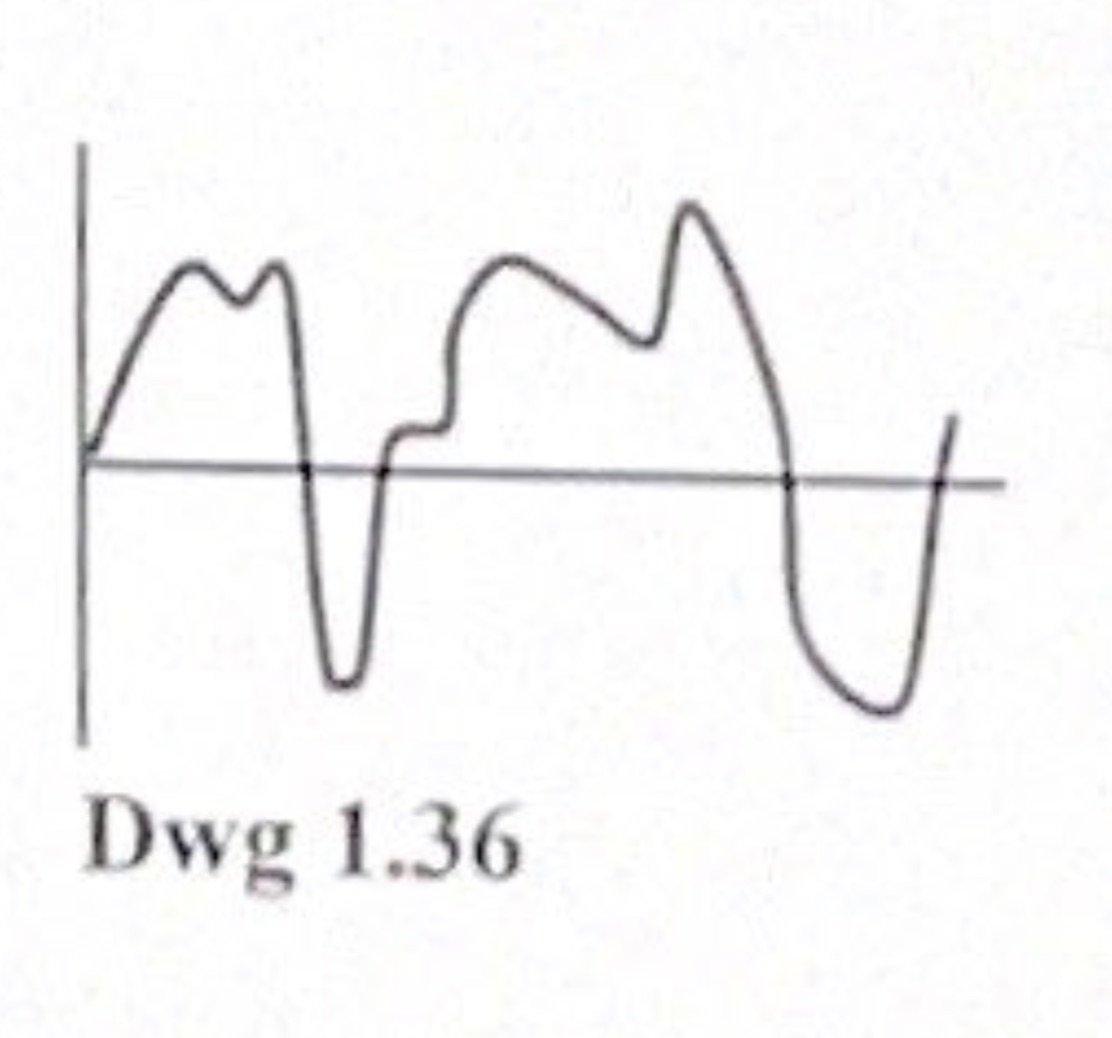 Depcition of VLF voltage output from the Fénix manual
Depcition of VLF voltage output from the Fénix manual
For random and otherwise unpredictable voltage generation, Fénix also has dedicated noise and sample and hold sections. There are dedicated circuits for both analog and digital flavors of noise and dedicated output level controls for both, and the digital noise also offers a Timbre knob and CV input to control its sample rate, and thus its spectral content. The noise section also has a third output called VLF, short for Very Low Frequency, which is a slow, fluctuating random voltage source derived from the digital noise circuit.
The nearby sample and hold circuit does exactly what the name suggests: it samples an input signal every time a gate or trigger is received, and holds the registered voltage until the next trigger. The characteristic sci-fi sound of random pitch percolations are often achieved with noise patched into S&H circuits, with the output sent to an oscillator's pitch input. But there's plenty of other uses as well, including stepped voltage generation and pseudo-bitcrushing effects.
Finally, while initially unassuming, Fénix provides two CV Mixers for manipulating the level and polarization of audio and control signals. CV MIX 1 sums two inputs, one simply at unity gain and the other with a bipolar attenuator, but also offers a variable offset control to shift a signal's centerpoint above or below zero volts. While CV MIX 2 functions similarly, the offset voltage is provided in discrete one volt intervals from -1V to +2V.
These CV mixers are incredibly handy for manipulating control voltages of course, however they can also be particularly helpful in the context of audio patches. In a patch similar to the video excerpt above, the adjacent recording demonstrates how its possible to turn the lowpass outputs of VCF 3 into a highpass filter. While the two pinged filters are running separately, VCF 3 is processing a blend of the noise sources. By running the lowpass output into a CV mixer to invert its polarity and then mixing that with the unprocessed noise, the resulting phase-cancellation effectively creates a highpass response—gently shaping the noise as part of a background texture.
External Interfacing: In and Out, Front and Back
Using everything Fénix has to offer already provides a lifetime of opportunities for sonic exploration without necessarily needing anything else. But, suppose you did want to play the Fénix oscillators with your favorite CV-generating keyboard or sequencer, or perhaps route external instruments through the filters. Thankfully, Vermuelen had considered these possibilities when designing this instrument, and provided synthesists with a few practical ways to interface with the outside world.
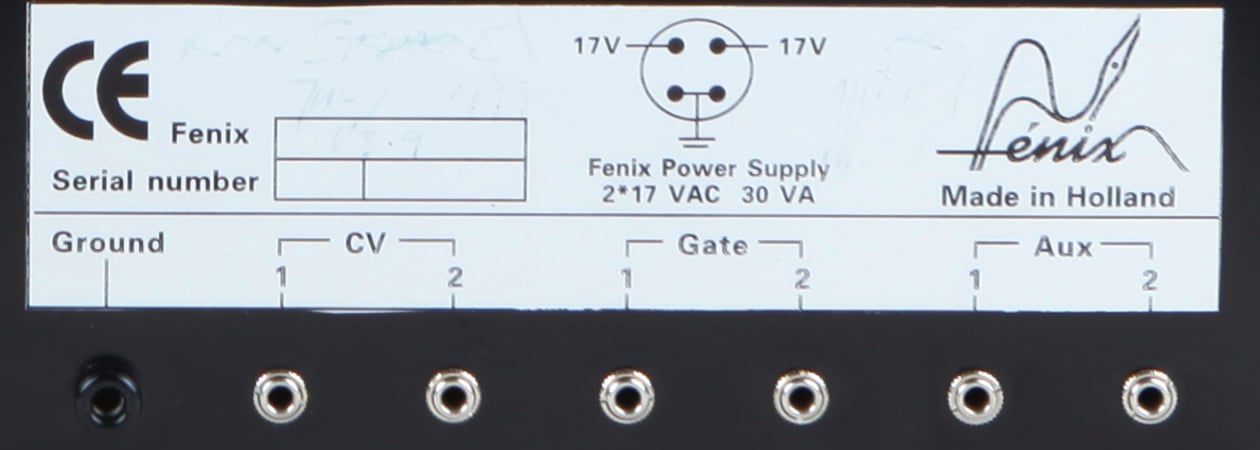 Fénix rear panel connections
Fénix rear panel connections
At the bottom left of the Fénix are bi-directional patch points to interface with connections made on the back of the unit. Given the general size of the instrument, it's feasible to imagine it semi-permanently installed in a studio environment, especially if connected to a CV keyboard or MIDI-to-CV converter device. This concept dates back to even the earliest of Moog modular systems, where "trunk lines" were available to provide front panel access to rear connections. Thus, Fénix has a set of six jacks for this purpose, with two each labeled CV, Gate, and Aux. There's also a Ground jack on the back, which is necessary for cross-patching multiple banana cable-based instruments, like other Fénix units or Serge systems. Since banana cables are single conductor wires, common ground must be established for reliable patching results to occur between multiple instruments.

On the rightmost area of the panel, Fénix has two 1/4" jacks for external audio input. While simply bringing audio into the Fénix can be valuable, they're also useful for generating control signals derived from whatever is being sent in. One simply contains an envelope follower, which smoothly tracks the amplitude of the input signal, and a threshold-based gate generator, while the other produces a sort of stepped-envelope with an associated trigger output. This makes the former ideal for melodic or sustained instruments, while the latter is optimized for percussive sounds. Of course, there's also a stereo 1/4" output, which affords the ability to transmit two channels of Fénix goodness out into the world.
In the adjacent video excerpt, I'm processing my guitar's audio signal with various parts of the Fénix. After shaping the tone with some pedals, the guitar is routed into the external audio inputs, with parallel feeds running through filters, ring modulators, and even the comparator for a harsh distortion-like effect. Envelope followers are handy for sweeping filters in an auto-wah fashion, but could be used to blend between layers, modify parameters of other elements, or a number of other uses.
The Fénix Legacy
So what happened after the run of 75 Fénix synthesizers? Well, for about 10 years nothing really happened. Vermuelen returned to doing other things after crafting his dream instrument, while sounds from the Fénix made occasional appearances in music from the likes of Aphex Twin and Coil. Once production ended, Fénix gained something of a cult following, and rumors that a follow up was in the works swirled around for years.
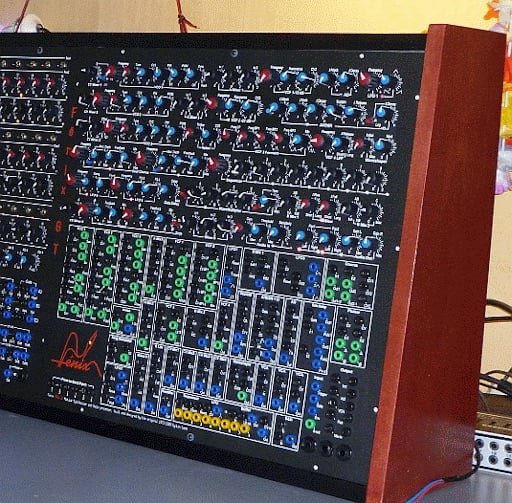 Fénix GT, which evolved into the separate Fénix II and III (image from dutchsynth.nl)
Fénix GT, which evolved into the separate Fénix II and III (image from dutchsynth.nl)
Finally in 2010, it was revealed that there would be not one, but two members of the Fénix family. Fénix II was a revised and expanded version of the original, refining the sound and offering additional features, like another filter, two more LFOs, a wave shaper, and a wave multiplier, among other improvements. For some more independence as a standalone instrument, Fénix II has an eight step sequencer, and some effects in the form of a phaser and an analog delay. The general format and philosophy largely remains the same from the original, but for many, it's these improvements that make the II feel like the definitive version of the Fénix.
Effectively completing the package, Fénix III was built to be the ultimate modular sequencer, just as the I and II were built to be the ultimate modular synthesizers. It offers three channels of sixteen step sequences, with two sets of CV and gate patterns available on channel A, and a wealth of other modules for generating control voltages, gates, and triggers. Five attenuators, a clock divider, and an abundance of inputs and utilities make it easy to modulate and manipulate sequences (or external voltages) to your heart's content. So while the addition of a simple sequencer on the Fénix II was appreciated, pairing it with the III blows the door open for crafting dense and complex patches. 100 total units were made in this production run, split into 75 and 25 each of the II and III, respectively. And for a time, it felt like this was the end of the Fénix story.
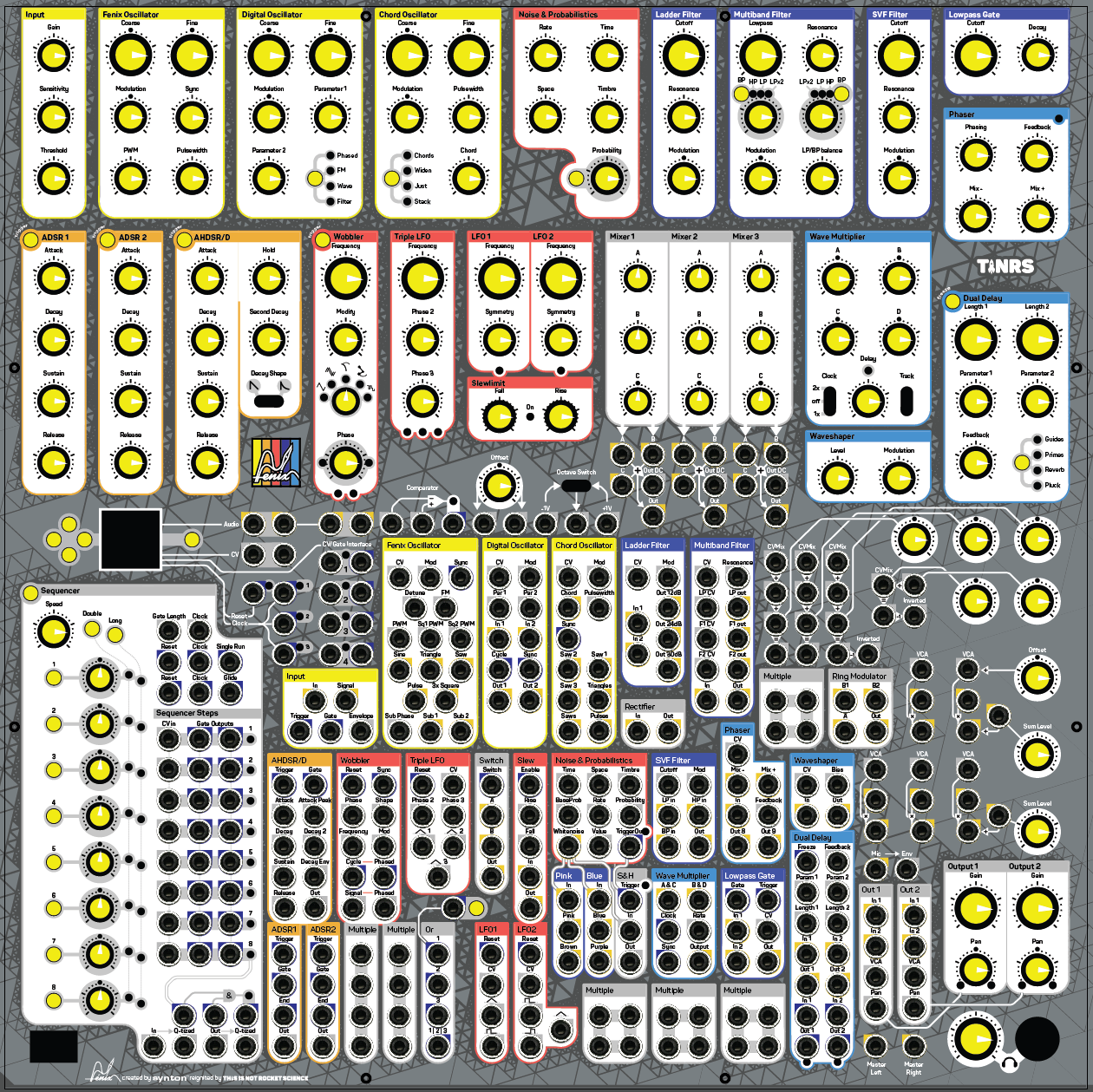
Then in 2018, fellow Dutch synthesizer makers This Is Not Rocket Science announced that they were working to revamp the Fénix once again, with the blessing and assistance from both Visser and Vermeulen. This iteration of the Fénix continues in the vein of the earlier models, with the addition of some TINRS digital magic, while maintaining much of the analog character which made the previous versions special. Digital effects, an LFO based upon their Wobbler module, a built-in oscilloscope, and other enhancements likely make this the most flexible Fénix yet. In fact, there's a number of blog posts tagged "Fénix" on their website, serving as an interesting insight into their development process, and those posts make it abundantly clear how excited they are to be a part of this legacy.
Notably, some significant differences include the transition to 3.5mm jacks as found on Eurorack modules, as well as the usage of surface mount components to decrease the overall size of the instrument. These changes will certainly be welcome in a world that has continued to embrace Eurorack as the predominant format for modular synthesizers, eliminating the need for format converters to fit in nicely with most existing setups. TINRS unveiled their prototype Fénix IV at Superbooth 2019, and since then have been diligently working on finalizing the design for production, with first units finally shipping in June 2021.
Beyond the fourth iteration, a couple of DIY options have been teased over the past few years. Vermuelen himself lists a page for Fénix IId on his website as an upcoming project, with details coming soon. Alternatively, a mysterious webpage appeared early last year for a clearly Fénix II-inspired DIY instrument called the Xenomorph, with a now-passed projected availability of spring 2020. Savvy internet users deduced that its domain was hosted with Black Corporation's website, which should be no surprise as designer Roman Filippov has a long history of breathing new life into old synthesizer designs, particularly in the realm of Buchla. It remains to be seen if either of these projects will actually see the light of day, but these and the work of TINRS prove the legacy of the Fénix is not just alive and well, but thriving.
While it might not be as well known as a Moog or Buchla modular system, the Fénix represents an interesting chapter in the history of synthesis. It came around at a time when renewed excitement for synthesizers really began to catch on again, and over the years has amassed a dedicated following of its own.
I am a firm believer that every instrument has something unique to offer, and the Fénix truly seems to shine in its breadth of flexibility to produce musically interesting patches. While its sounds could conceivably be patched up on a number of other instruments, there's something to be said for the way a specific instrument's design philosophies inspire certain results to occur. Even if only a limited number of Fénix instruments are out there, the fact that it even exists at all is a testament to the passion and spirit of people like Bert Vermuelen, who are continually inspired by analog synthesizers and share their own ideas and concepts for electronic musical instruments with the world.







